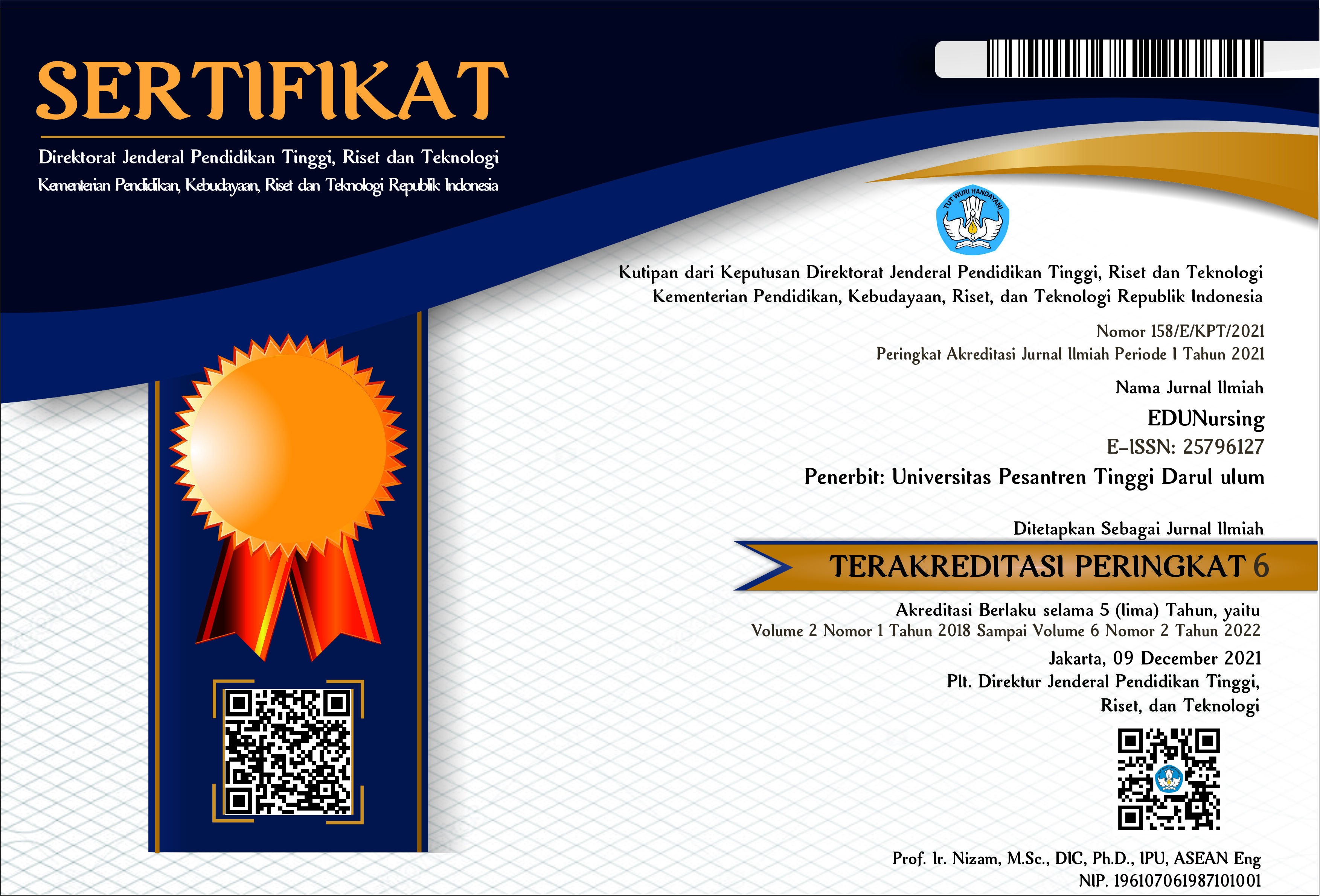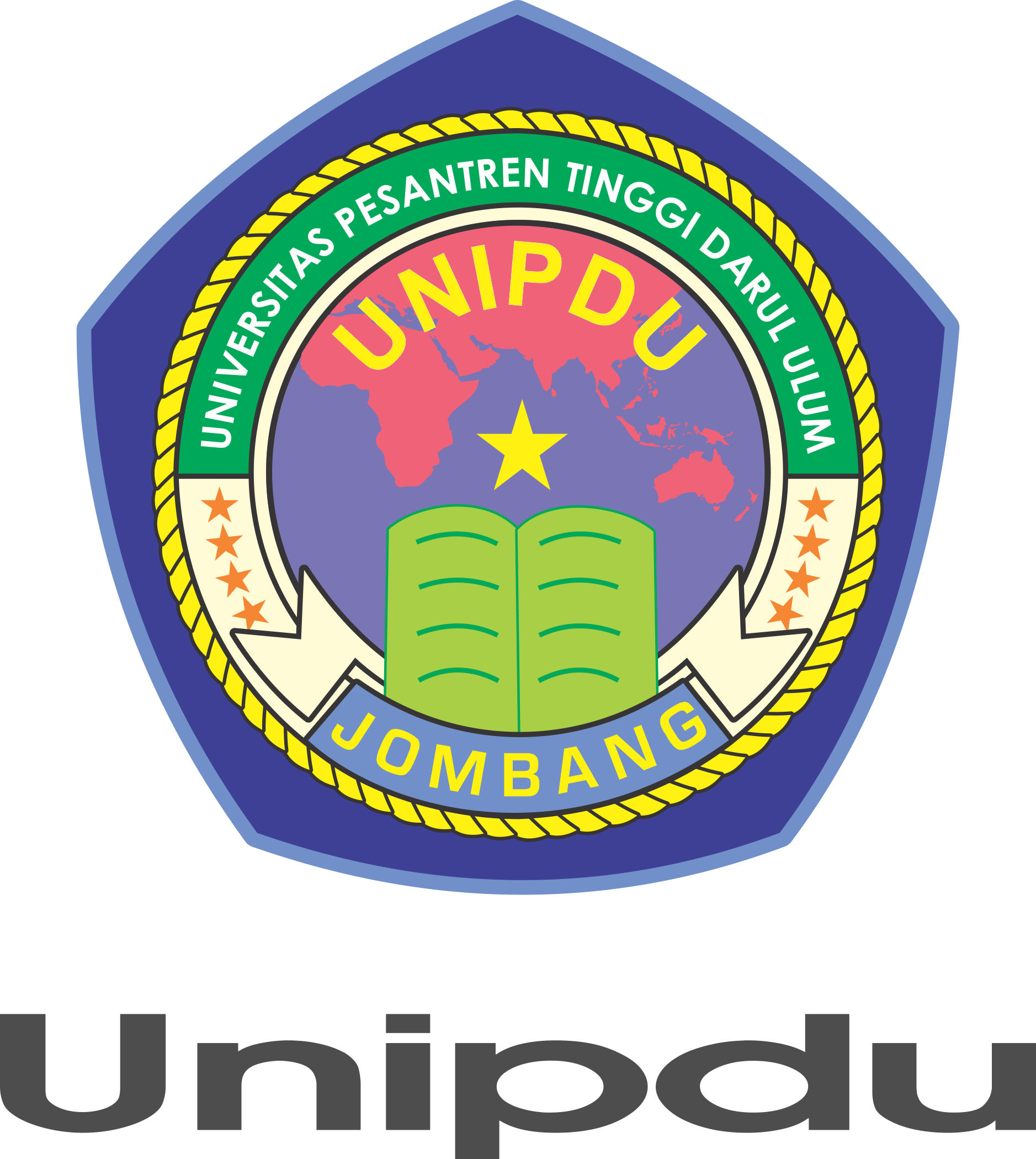PENGARUH GPM (GERAKAN PESANTREN MENYENANGKAN) TERHADAP KEJADIAN BULLYING PADA SANTRI DENGAN PENDEKATAN TEORI PERUBAHAN KURT LEWIN
https://doi.org/10.26594/edunursing.v5i1.2315
Abstract
AbstractBullying is one of a nature of hurting or distrubing behaviours toward victim, the victim can be a person or group. The Prevalence of bullying mostly occurs among adolescents, especially adolecents who are live in boarding schools. Many efforts have been made to prevent bullying, but this problem is still appearance until nowdays. The methodology research on this study was used literature review obtained PubMed, Science Direct, DOAJ, and Google Scolar. This study also obtined 10 literature. There results of this study found that there was an influence of GPM (Gerakan Pesantren Menyenangkan) to bullying incidence among santri by using Kurt Lewin's Change Theory. GPM (Gerakan Pesantren Menyenangkan) is a program to emotions expression of santri, the happy, sad and angry expression can expresses or mentions in emotional zone which available in their room, so this will make their friends know what are their felling and this also make sense between the santri then the environment became more conducive and of prevent bullying behavior among santri. The implementation of the GPM program by using Kurt Lewin's Change Theory has 3 stages, The first stage Unfreezing, Santri committed to implementing the program, as well get an understanding of bullying. The second stage Moving, Santri run the GPM program so that the environmental conditions are orderly and conducive. The third stage Refreezing, santri agreed and carried out and obeyed the rewards and regulations understanding of bullying.
Keywords : Bullying, GPM Programe, Kurt Lewin's Change Theory.
References
DAFTAR PUSTAKA
Afriana, M. & U. (2014) ‘Upaya Mengurangi Perilaku Bulliying di Sekolah dengan Menggunakan Layanan Konseling Kelompok’, Jurnal Psikologi, 01, p. 02.
Aisiya, I. & (2015) ‘Exploring bullying in nigerian secondary school and school administrators strategies for its’ management department of educational administration and policy studies’, Journal of Educational and Social Research, 5, p. 2. Available at: doi:10.5901/jesr.2015.v5n2p305.
Amri, N. (2019) Peilaku Bulliying di Pondok Pesantren Studi Fenomenologi Bulliying di Asrama Al-Risalah Pondok Pesantren Mambaul Ma’aarif Denanyar Jombang. Universitas Islam Negeri Sunan Ampel Surabaya.
Astuti (2008) 3 Cara Meredam Bullying. Jakarta: PT. Gramedia Widasarana Indonesia.
Bonell, C. (2019) ‘Modifying the secondary school environment to reduce bullying and aggression : the INCLUSIVE cluster RCT’, Public Health Research, 7(18), pp. 1–164. doi: 10.3310/phr07180.
Desiree (2013) ‘Bullying di Pesantren ( Studi Deskriptif di Pesantren “ X ” Depok )’, DepartemenIlmu, Departemen Sosial, Kesejahteraan Indonesia, Universitas, Vol.01, p. Hal.01-17.
Endang, F. & A. M. (2014) ‘Kecendrungan melakukan bulliying ditinjau dari jenis kelamin dan urutan kelahiran pada santri di pondok pesantren’, Jurnal Psikologi Untag, Vol 1, p. 1.
Ernawati (2018) ‘Sosialisasi Meningkatkan Kesadaran Santri terhadap Tindakan Bullying di Pesantren’, Jurnal Abdi MOESTOPO, 01(02), pp. 38–44.
Hidayati, N. (2012) ‘Bulliying pada Anak : Analisis dan Alternatif Solusi’, Jurnal Psikolog Universitas Muhammadiyah Gresik., vol.15, p. 46.
Irwan (2017) Etika dan Perilaku Kesehatan. Yogyakarta: Absolute Media.
Keliat, & P. (2016) Keperawatan Jiwa Terapi Aktivitas Kelompok. Jakarta: ECG.
Kevin (2019) ‘Crime Prevention Through Environmental Design (CPTED) Characteristics Associated With Violence and Safety in Middle Schools’, HHS Public Access, 88(4), pp. 296–305. doi: 10.1111/josh.12609.Crime.
Konold, T. et al. (2017) ‘Racial / Ethnic Differences in Perceptions of School Climate and Its Association with Student Engagement and Peer Aggression School Climate’, Journal of youth and adolescence, 46(6), pp. 1289–1303. Available at: https://doi.org/10.1007/s10964-016-0576-1.
KPAI (2018) Komisi Perlindungan Anak Indonesia Kasus Bullying dan Pelaku Bullying. Available at: available: http://www.kpai.go.id/berita/kpai-kasus-bullying-dan-pelaku-bullying/.
Liu, & Graves, N. (2011) ‘Childhood bullying: A review of constructs, concepts & nursing implications’, Public Health Nursing, 28, pp. 556–568.
PKM (2019) ‘Gerakan Pondok Menyenangkan’, in Program Kreativitas Mahasiswa. Unipdu Jombang.
Retnowuni, A. & Y. A. L. (2019) ‘Pengalam Santri Mengikuti Program GPM ( Gerakan Pondok Menyenangkan ) Terhadap Perilaku Bullying Di Pesantren’, Jurnal EDU Nursing, 3(2), pp. 109–118.
Suryanto, et a (2012) Pengantar Psikologi. Surabaya: Airlangga Universitiy Press.
Wisnu, S. (2014) ‘Profil Kepribadian Siswa Korban Bullying’, Jurnal Psikologi Integratif, Vol. 2, p. 9.
Yani, W. & L. (2016) ‘Fenomena korban bullying pada kesehatan jiwa remaja di pesantren’, Jurnal Ilmu Keperawatan, 4, pp. 25–33.
Yuhbaba, Z. N. (2019) ‘Eksplorasi Perilaku Bullying di Pesantren’, Jurnal Kesehatan dr. Soebandi, 7(1), pp. 63–71.
Downloads
Published
How to Cite
Issue
Section
License









